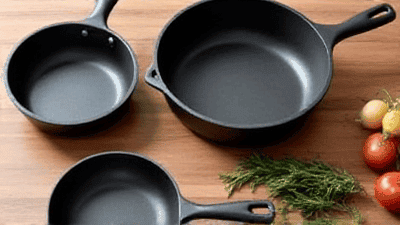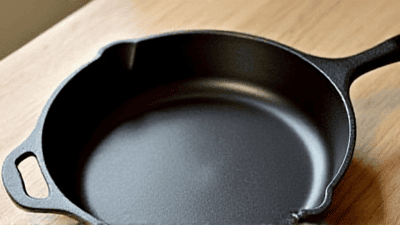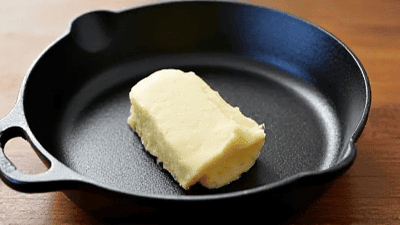
Cast iron pans have long been a favorite among home cooks and professional chefs alike. Known for their durability and excellent heat retention, these versatile cooking tools can be used for a variety of techniques, from searing and sautéing to baking and frying. While cast iron pans are renowned for their ability to develop a natural non-stick surface over time, they also require proper care and maintenance to ensure that they last for generations.
Cast iron cookware dates back to ancient times, with roots in China during the Han Dynasty. The technique spread to Europe, where it was widely used for its ability to withstand high heat and its durability. Throughout the centuries, cast iron pans have remained a staple in kitchens around the world.
As cooking methods evolved, so did the design of cast iron cookware. Today, you can find various types of cast iron pans, including skillets, Dutch ovens, and griddles, each serving its purpose while maintaining the core benefits of cast iron.
Durability: Cast iron pans can last a lifetime if cared for properly and can even improve with age as they develop a natural non-stick surface.
Heat Retention and Distribution: Cast iron retains heat exceptionally well, allowing for even cooking. This property makes them ideal for searing meats and baking.
Versatile Cooking Options: Cast iron pans can be used on the stovetop, in the oven, over an open flame, and even on the grill.
Natural Non-Stick Surface: With proper seasoning, cast iron pans develop a non-stick surface that enhances the flavors of the food cooked in them.
Iron Fortification: Cooking in cast iron can fortify your food with iron, an essential mineral.

Before diving into care techniques, it’s important to understand the different types of cast iron cookware available:
Cast iron skillets are the most common and versatile type of cast iron cookware. They come in various sizes and can be used for frying, sautéing, baking, and more.
Dutch ovens are heavy, thick-walled pots with a tight-fitting lid. They are perfect for braising, slow cooking, and baking.
Cast iron griddles have a flat surface and are great for cooking pancakes, burgers, and other foods that require a large cooking area.
Cast iron woks provide excellent heat distribution and are perfect for stir-frying, making them an excellent addition to your kitchen.
Seasoning is the process of creating a natural non-stick surface on your cast iron cookware. It involves applying oil and heating the pan to polymerize the oil, forming a protective layer. Here's how to do it:
Clean the Pan: If your cast iron pan is new or has remnants of food, scrub it with hot water and a stiff brush. Avoid soap for this initial cleaning; instead, use coarse salt as an abrasive if necessary.
Dry Thoroughly: Dry the pan completely with a clean cloth or paper towel. Any remaining moisture can cause rust.
Apply Oil: Use a paper towel to apply a thin layer of vegetable oil, flaxseed oil, or shortening to the entire cooking surface of the pan. Be sure to coat the sides and handle as well.
Heat the Pan: Preheat your oven to 375°F (190°C). Place the pan upside down on the middle rack to prevent excess oil from pooling in the bottom. You can place a baking sheet on the bottom rack to catch any drips.
Bake: Bake for about an hour. This process allows the oil to polymerize and bond to the surface of the cast iron.
Cool Down: Turn off the oven and let the pan cool inside. This gradual cooling helps prevent cracking or warping.
Repeat: For best results, repeat the seasoning process two to three times to build up a strong non-stick surface.

Cleaning cast iron requires special care to avoid damaging the seasoning. Here are recommended cleaning methods:
After using your cast iron pan, let it cool slightly but not completely. Pour some coarse salt into the pan and scrub it with a paper towel or a soft brush. The salt acts as an abrasive, removing food particles without damaging the seasoning.
If there’s stubborn residue, pour a small amount of hot water into the pan. Use a brush to scrub while the pan is still on the heat. This method helps loosen stuck-on food with steam.
Avoid using soap, as it can break down the seasoning layer. Never put your cast iron pan in the dishwasher, as this can lead to rust and damage.
After cleaning, dry the pan thoroughly with a cloth or by heating it on the stovetop. Any moisture left can cause rust.
Keeping your cast iron pan in good condition requires regular maintenance. Here are some tips to ensure longevity:
Even with proper cleaning, the seasoning can wear down over time. Re-season your pan periodically, especially after cooking acidic foods (like tomatoes) or if food begins to stick.
Store your cast iron pan in a dry place. If you stack pans, place a paper towel between them to protect the cooking surface.
Cooking highly acidic foods (like tomatoes or vinegar-based sauces) can break down the seasoning. If you do cook these foods, be sure to re-season your pan afterward.
Avoid dropping your cast iron pan or exposing it to sudden temperature changes, as this can cause cracks or warping.

Once you have a well-cared-for cast iron pan, it's time to explore the various cooking techniques you can employ.
Searing is one of the most popular uses for cast iron pans. The high heat retention allows for a perfect crust on meats. Preheat the pan until it’s hot before adding oil, then place the meat in the pan without overcrowding.
Cast iron pans can go from stovetop straight into the oven. Use them to bake cornbread, frittatas, or even cakes. Make sure to preheat the pan for better results.
Whether deep-frying or pan-frying, cast iron is an excellent choice. The material retains heat well, ensuring consistent cooking. Choose oil with a high smoke point for frying.
Sautéing with cast iron provides excellent flavor. Use medium to high heat and avoid overcrowding the pan, as this can lower the temperature and cause steaming.
Toss vegetables in oil and seasonings, then roast them in a preheated cast iron pan. The result is beautifully caramelized vegetables with a great texture.
Even with the best care practices, issues may arise. Here’s how to troubleshoot common problems:
If you notice rust spots, remove them by scrubbing with a mixture of coarse salt and oil. Season the pan again once the rust is removed.
If food begins to stick, it may indicate that the seasoning is wearing off. Clean the pan thoroughly and re-season it.
If your cast iron pan heats unevenly, make sure it is preheated properly before cooking. Additionally, ensure the burner covers the entire base of the pan.
If your food tastes metallic or off, it may be due to overcooked or burnt food particles on the surface. Clean the pan thoroughly to remove residues.
Here are a few delicious recipes that highlight the versatility of cast iron cooking:
Ingredients:
Instructions:
Ingredients:
Instructions:
Ingredients:
Instructions:
Cast iron pans are a timeless kitchen tool that can bring flavor, durability, and versatility to your cooking. With proper care and maintenance, these pans can last for generations, enhancing your culinary adventures. Whether you are searing meats, baking cornbread, or making a one-pan meal, mastering the use of cast iron cookware opens up a world of cooking possibilities.
By following the guidelines laid out in this guide, you will not only ensure that your cast iron pan remains in pristine condition but also unlock the full potential of this extraordinary cooking tool. So roll up your sleeves, embrace the art of cast iron cooking, and enjoy the delicious creations that come from your kitchen!